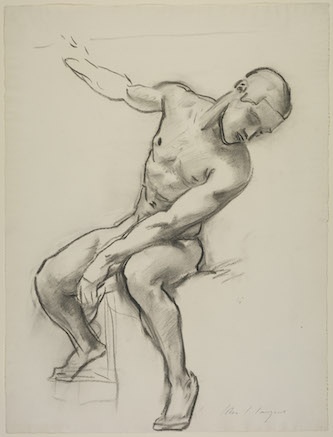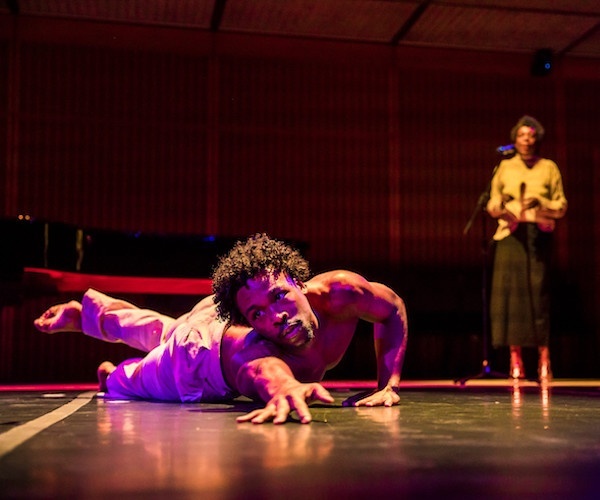Visual Arts Commentary: Museums are Getting Woke for Real
By Jon Garelick
By digging deep into Thomas McKeller, the Gardner Museum has not only resurrected a lost figure (and lost music, and “lost” art) but revealed and contributed to an ongoing history.

Dancer Tyeri Morrison and pianist Lara Downes in “Meeting Thomas McKeller.” Photo: Matt Teuten.
When it comes to diversity, museums are generally the last place you’d look. Dead white males, or even not-so-dead-white males, are the order of the day and the century, whether it’s the Museum of Modern Art, the Whitney (you GO, Gorilla Girls!) or the Metropolitan Museum of Art (thank you, Morgan, Vanderbilt, Rockefeller, and the rest of you), and, in Boston, the Museum of Fine Arts and the Isabella Stewart Gardner Museum.
But something’s happening — whether it’s the Kent Monkman commission “mistikosiwak (Wooden Boat People)” in the Great Hall of the Met, or black artist Faith Ringgold’s apocalyptic “Die” (1967) opposite Pablo Picasso’s iconic “Les Demoiselles d’Avignon” (1907), and any number of related shows and curatorial moves emphasizing diversity and inclusion.
It’s easy enough to brush off all this as too little too late, but the impact of shows like the MFA’s recent Ancient Nubia Now exhibit is undeniable – the last day of the show was MLK Day, and the place was packed, including more black faces than I’ve seen in the museum at one time in more than 40 years as a regular visitor.
Now comes the Gardner’s Boston’s Apollo: Thomas McKeller and John Singer Sargent — a deep dive into the life and times of McKeller, longtime model for John Singer Sargent, international art star, the darling of Boston society, close pal of his patron Isabella Stewart Gardner.
The heart of the show is the nude drawings that Sargent produced of McKeller, a black man, as studies for his commissioned mural for the rotunda of the Museum of Fine Arts. In the finished work — of mythological figures — McKeller’s black body served as the model for white figures, men and women. Or, as McKeller himself wrote about the figure of Apollo in a letter included in the show, “That was my body except my head.”

John Singer Sargent, Study of a Seated Male Nude for the Rotunda or Grand Staircase of the Museum of Fine Arts, Boston, 1916–1921. Charcoal on paper. Photo: Courtesy of the Gardner Museum.
The show is heavy with context, argument, apology. A timeline of photos and wall text gives an overview of black life in Boston from the establishment of the Harriet Tubman House in 1906 through the founding of the Guardian newspaper, Elma Lewis’s arts leadership, and basketball legend Bill Russell’s tenure with the Celtics. All interspersed with key events in the life of McKeller, Sargent, and Gardner.
There are also wall-text arguments about the Sargent-McKeller drawings — here’s everything: sex, race, class. There are legitimate questions about the relationship between artist and model, black man and white. But for me, there could have been a third less context.
None of which detracted from the energy, flow, and deft economy of Sargent’s lines, the drawings’ emotional warmth and frank eroticism, or the overwhelming presence of the one oil portrait in the show, a McKeller nude that Sargent painted for himself and kept in his studio until the end of his life.
The Gardner is presenting a variety of talks and concerts related to the McKeller show and, for me, the concert program “Meeting Thomas McKeller,” in the Gardner’s Calderwood Hall, on February 13, was worth any number of wall texts.
Assembled by singer, performance artist, and guest curator Helga Davis, the show’s breadth and depth were remarkable. Davis herself introduced the show with a bravura a cappella performance of her own (improvised?) arrangement of “The Star-Spangled Banner,” with startling multi-octave jumps in register, and funny asides (“Never mind, I don’t like this part”) while Tyeri Morrison danced solo, shirtless in white pants.
Davis, it turned out, was an assured, charming host. She introduced pianist Lara Downes, who played “lost” (until recently) music of Florence Price (1887-1953), with its folkloric echoes of Joplin and Louis Moreau Gottschalk and Chopin-esque flourishes. There was other music by black composers of McKeller’s lifetime (Price’s Boston connection is that she was the first female black graduate of New England Conservatory), set to dances commissioned by the Gardner from choreographer Lei Philip Marsman, the best of which might have been a kind of exuberant cross between ballroom dancing and folk dance, the two men (Morrison’s McKeller and Shaun Patrick Ferren’s Sargent) and five women in colorful, vaguely period costume — the movement was fast-moving, formally complex, and touched with wit (I laughed out loud a couple of times at the sudden stark moves into the “modern”).
The elegant bass-baritone Davóne Tines sang Price’s setting of Langston Hughes’s “Song to the Dark Virgin,” and Tines, joined by the 10-piece Isabella Ensemble, conducted by George Steel, sang letters set to music by Bongani Ndodana-Breen, another world premiere Gardner commission.

Dancer Tyeri Morrison and guest curator/host Helga Davis in “Meeting Thomas McKeller.” Photo: Matt Teuten.
On one level, the evening was about Sargent and McKeller’s years-long working relationship. The artist discovered his model employed as an elevator operator at the Vendome Hotel. McKeller lived most of his life in Boston’s South End and Roxbury while moving in white society. (One piece was called “Colored.”)
Curator Nathaniel Silver talked about how he discovered the drawings of McKeller in the Gardner’s archives and realized that all these many drawings of a black man were the source for Sargent’s paintings of white men.
The artists (including Downes, Tines, and composer Ndodana-Breen) talked about their feeling engaging with Sargent’s drawings, and Tines, for one, said that no matter what he sings — whether it’s Mozart’s “Requiem” in Alice Tully Hall or a modern secular work — he will always be “a tall black man,” a fact he was free to work with or against, but could never forget.
In one of the most touching moments in the evening, Davis introduced McKeller’s great grand-niece Deirdre McKeller O’Bryant — Davis had said that the evening was about “reuniting one family with its story.” But it was more than that. It was an example of how rigorous devotion to a specific story can make it universal. In its way, the evening itself was a work of art.
This was a Boston story and an American story. By digging deep into McKeller, the Gardner has not only resurrected a lost figure (and lost music, and “lost” art) but revealed and contributed to an ongoing history.
Tokenism this was not.
Helga Davis will host a post-concert conversation at the Gardner with distinguished baritone Lawrence Brownlee following Brownlee’s performance of Robert Schumann’s classic “Dichterliebe” song cycle and genre-crossing American composer Tyshawn Sorey’s 2017 “The Cycles of My Being” (text by Terrance Hayes), March 15 from 1:30 to 3 p.m.
Jon Garelick is a member of the Boston Globe editorial board. A former arts editor at the Boston Phoenix, he writes frequently about jazz for the Globe, Arts Fuse, and other publications.
